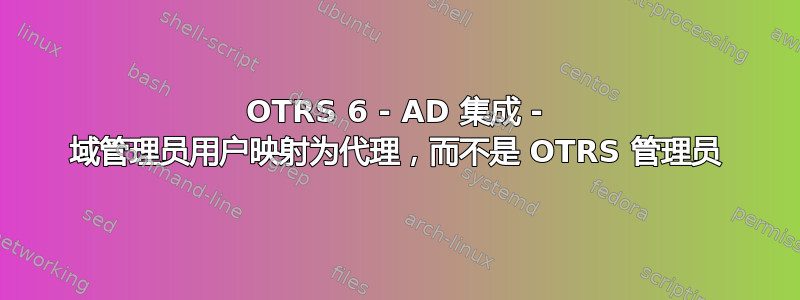
我正在使用 ITSM 模块测试 OTRS 6。目前我只在我们的 DEV 环境中测试它,所以如果这是最简单的方法,放弃一切并从头开始也不会有问题。不过,我打算很快将其投入生产。
我按照官方文档“严格按照书上的步骤”安装了它,并且效果非常好!(编辑:安装在 Ubuntu Server 18.04 LTS 上)我让所有用户使用 MySQL 上的用户数据库进行本地身份验证。我让客户、代理和管理员都能够进行身份验证并显示正确的用户面板。
之后,我成功地将 OTRS 与我的 AD 集成,但有一个问题:我的所有 AD 用户都映射为客户,我的所有域管理员(也属于 OTRS_Admins AD 组)都是代理,并且……我没有账户来管理 OTRS。根本没有管理员。
我该怎么办?如何将我的域管理员映射为 OTRS 管理员而不是代理?如何将我的一些域用户映射为代理?我做错了什么吗?我完全迷茫了。
官方文档没有太多帮助,而且我在 Google 上找不到任何有我特定需求的人。
我的(已编辑)Config.pm:
$Self->{'AuthModule'} = 'Kernel::System::Auth::LDAP';
### OTRS Admin Auth
###
$Self->{'AuthModule::LDAP::Host'} = '192.168.179.2'; # AD Server
$Self->{'AuthModule::LDAP::BaseDN'} = 'dc=test,DC=local'; # Domain
$Self->{'AuthModule::LDAP::UID'} = 'sAMAccountName';
$Self->{'AuthModule::LDAP::GroupDN'} = 'CN=OTRS_Admins,CN=Users,DC=test,DC=local'; #OTRS Admin group
$Self->{'AuthModule::LDAP::AccessAttr'} = 'member';
$Self->{'AuthModule::LDAP::UserAttr'} = 'DN';
$Self->{'AuthModule::LDAP::SearchUserDN'} = 'svc_otrs'; #OTRS service user
$Self->{'AuthModule::LDAP::SearchUserPw'} = 'Passw0rd'; #And its passwird
$Self->{'AuthModule::LDAP::AlwaysFilter'} = '';
$Self->{'AuthModule::LDAP::Params'} = {
port => 389,
timeout => 120,
async => 0,
version => 3,
sscope => 'sub'
};
### User Sync
### AD <==> DB OTRS (MySQL)
$Self->{'AuthSyncModule'} = 'Kernel::System::Auth::Sync::LDAP';
$Self->{'AuthSyncModule::LDAP::Host'} = '192.168.179.2'; # AD SRV
$Self->{'AuthSyncModule::LDAP::BaseDN'} = 'dc=test,DC=local'; # Domain
$Self->{'AuthSyncModule::LDAP::UID'} = 'sAMAccountName';
$Self->{'AuthSyncModule::LDAP::SearchUserDN'} = 'svc_otrs';
$Self->{'AuthSyncModule::LDAP::SearchUserPw'} = 'Passw0rd';
$Self->{'AuthSyncModule::LDAP::UserSyncMap'} = {
# DB -> LDAP
UserFirstname => 'givenName',
UserLastname => 'sn',
UserEmail => 'mail',
};
$Self->{'AuthSyncModule::LDAP::UserSyncInitialGroups'} = [
'users', 'basic_admin',
];
$Self->{'Customer::AuthModule'} = 'Kernel::System::CustomerAuth::LDAP';
$Self->{'Customer::AuthModule::LDAP::Host'} = '192.168.179.2';
$Self->{'Customer::AuthModule::LDAP::BaseDN'} = 'dc=test,DC=local';
$Self->{'Customer::AuthModule::LDAP::UID'} = 'sAMAccountName';
$Self->{'Customer::AuthModule::LDAP::SearchUserDN'} = 'svc_otrs';
$Self->{'Customer::AuthModule::LDAP::SearchUserPw'} = 'Passw0rd';
$Self->{CustomerUser} = {
Module => 'Kernel::System::CustomerUser::LDAP',
Params => {
Host => '192.168.179.2', # AD Server
BaseDN => 'dc=test,DC=local', #Domain
SSCOPE => 'sub',
UserDN =>'svc_otrs', #OTRS Service User
UserPw => 'Passw0rd', #its password
AlwaysFilter => '(&(samAccountType=805306368)(!(userAccountControl:1.2.840.113556.1.4.803:=2)))',
SourceCharset => 'utf-8',
DestCharset => 'utf-8',
},
CustomerKey => 'sAMAccountName',
CustomerID => 'mail',
CustomerUserListFields => ['sAMAccountName', 'cn', 'mail'],
CustomerUserSearchFields => ['sAMAccountName', 'cn', 'mail'],
CustomerUserSearchPrefix => '',
CustomerUserSearchSuffix => '*',
CustomerUserSearchListLimit => 10000,
CustomerUserPostMasterSearchFields => ['mail'],
CustomerUserNameFields => ['givenname', 'sn'],
Map => [
# note: Login, Email and CustomerID needed!
#[ 'UserSalutation', 'Title', 'title', 1, 0, 'var' ],
[ 'UserFirstname', 'Firstname', 'givenname', 1, 1, 'var' ],
[ 'UserLastname', 'Lastname', 'sn', 1, 1, 'var' ],
[ 'UserLogin', 'Login', 'sAMAccountName', 1, 1, 'var' ],
[ 'UserEmail', 'Email', 'mail', 1, 1, 'var' ],
[ 'UserCustomerID', 'CustomerID', 'mail', 0, 1, 'var' ],
[ 'UserPhone', 'Phone', 'telephonenumber', 1, 0, 'var' ],
#[ 'UserAddress', 'Address', 'postaladdress', 1, 0, 'var' ],
#[ 'UserComment', 'Comment', 'description', 1, 0, 'var' ],
],
};
答案1
事实上,这是一个由三部分组成的问题:
- 当我使用 LDAP 后端时,我丢失了 DB 后端的用户(包括 root@localhost 超级用户)
- LDAP 后端的代理用户没有管理员权限
- OTRS 文档有些地方有点过时
问题 1:丢失了我的数据库后端
在中Config.pm,我插入了以下行来选择代理后端:
$Self->{'AuthModule'} = 'Kernel::System::Auth::LDAP';
嗯,这一行的作用是覆盖系统中其他地方的原始后端选择器。因此,为了拥有 DB 后端管理员用户以及 LDAP 代理用户,您应该使用 OTRS 自己的(和记录的!)方法来拥有多个后端,即在模块实例后附加数字后缀(请注意 de1紧接着AuthModule):
$Self->{'AuthModule1'} = 'Kernel::System::Auth::LDAP';
当然,你必须在所有模块的属性中都输入数字:
$Self->{'AuthModule::LDAP::Host1'} = '192.168.xx.xx';
$Self->{'AuthModule::LDAP::BaseDN1'} = 'dc=test,DC=local';
$Self->{'AuthModule::LDAP::UID1'} = 'sAMAccountName';
$Self->{'AuthModule::LDAP::GroupDN1'} = CN=GS_OTRS_Agents,CN=Users,DC=test,DC=local';
$Self->{'AuthModule::LDAP::AccessAttr1'} = 'member';
$Self->{'AuthModule::LDAP::UserAttr1'} = 'DN';
$Self->{'AuthModule::LDAP::SearchUserDN1'} = 'OTRS'; #OTRS LDAP User
$Self->{'AuthModule::LDAP::SearchUserPw1'} = 'somepass'; #Password for the LDAP User
$Self->{'AuthModule::LDAP::AlwaysFilter1'} = '';
$Self->{'AuthModule::LDAP::Params1'} = {
port => 389,
timeout => 120,
async => 0,
version => 3,
sscope => 'sub'
};
(将其与上面原始问题中发布的代码进行比较。)
公平地说,OTRS 管理手册中有一节解释了如何更改后端以及如何拥有多个后端。但是缺少了有关如果使用$Self->{'AuthModule'}而不是$Self->{'AuthModule1'}将覆盖本机 DB 后端而不是同时运行这两个后端的信息。花了很多脑力才弄清楚这一点。
这解决了失去管理员用户的问题,这些用户都在原始数据库后端。所有 LDAP 代理都不是完全管理员,因此他们可以回答工单,但不能以管理员身份管理 OTRS 系统。这样,我就拥有了两种用户。
这引出了第二个问题。
问题 2:LDAP 后端的代理用户没有管理员权限
我的意思是,我必须能够在我的 AD 上创建代理用户,并且他/她也应该能够成为管理员。而且他们确实是!
`$Self->{'AuthSyncModule::LDAP::UserSyncInitialGroups'} = [
'users',
];`
如果我不仅将“用户”添加到该列表中,还将“basic_admin”添加到该列表中,那么我的所有初始代理也将是管理员。我可以稍后撤销他们的管理员权限,但由于问题 1,我被锁定在 OTRS 之外,没有管理员用户,因此我无法授予或撤销任何人的管理员权限。
毕竟,我选择保持现状,并以用户身份创建我的代理,因为我已经将我的原始 root@localhost 用户设置为管理员(因为我已经解决了问题 1),并且将手动授予我所有未来管理员的管理员权限。但这是 OTRS 管理手册中另一个记录不太好的细节。
问题 3:OTRS 管理手册未完全更新
我理解,对于所有开源项目来说,这种情况时有发生。但是,到处都存在一些陷阱,这是由于从未更新的 OTRS 的先前版本继承而来的误导性信息造成的。例如,有些属性在手册中提到,但对版本 6 无效。
我偶然发现了一个适用于版本 5 并且未从版本 6 中清除的版本。我的意思是,指向属性的 QuickRef 页面的链接已被删除,因为该页面 - 以及属性 - 不再存在,但它仍然在手册的其他地方的重要配置部分中被提及。


